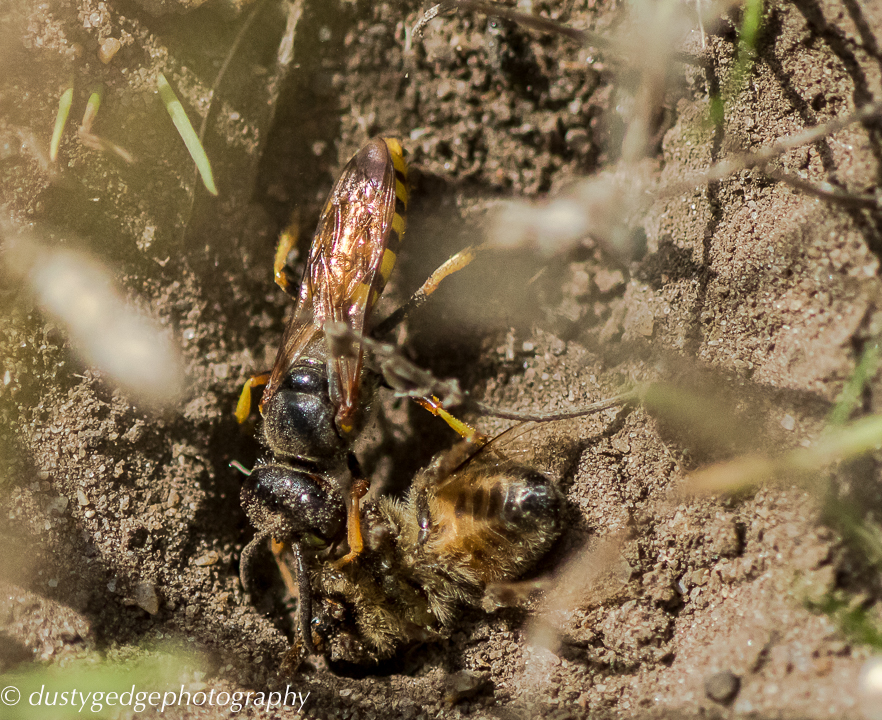The Wildlondoncomp is a photography competition to promote the campaign for London’s national park status. It is running until mid-August. I have already posted a few images, but from today I will be writing about why these images are important to the idea of a National Park for London.
Honey bees and Bee wolves
When it comes to cities and bees, there is all too often a focus on the honey bee. There are good reasons for this:
it is the declining number of honey bees that have been hitting the headlines in the press over the last ten years
when it comes to people they do give us something directly – honey.
When it comes to the declining numbers of pollinators, the honey bee generally takes centre stage. However, it is the other species, such as solitary bees, wasps, bumblebees and other insects that should really be the focus of our attention. It is these, and not the honey bee, that are responsible for the majority of pollination in the UK.
The Bee wolf main claim to fame is that it hunts honey bees. Hence its name ‘wolf’. But it is also a good pollinator.
Bee wolves – why Wildlondoncomp
Bee wolves are a relatively recent addition to the London fauna. And they nest in some pretty odd places. Essentially, the Bee wolf likes soft, sandy soils. Many of London’s large green spaces are perfect places for this species – the heaths and commons across the capital. I see them on Blackheath, but I know they are present on Wimbledon Common, Hampstead Heath and many other large semi-wild spaces.
But here’s the rub. What connects the Bee wolf to the average citizen in the capital? Most of the places where I find them nesting are on areas of bare ground created by people’s feet. Wandering along dusty paths, Londoners create small bare areas that are ideal for Bee wolves and other nesting pollinators. I have written about this recently and you can read and watch the video here.
They are, however, not limited to semi-wild places. A mention on the BWARs site, the bible for bees, ants and wasps in the UK states:
‘…nesting aggregations have been found… on the Battersea Bridge roundabout, Greater London.’
I am sure I read that they have also been found nesting on a roundabout in Acton. Therefore, this great rarity 20 years ago is now found across London, not just in the ‘wilder’ parts of the capital but amongst its infrastructure.
Londonwildcomp – the images
Back to the Wildlondoncomp, the images I posted today show the Bee wolf collecting honey bees.
The final image shows the wolf arriving at its hole and trying to get the payload down its burrow.
London Wildlife is more than the honey bee
So the Bee wolf represents the fascinating unsung and more often than not unnoticed wildlife in the capital. This makes the species a good subject for the competition. Roundabouts are part of London’s infrastructure as are green roofs. So London’s green infrastructure does play an active role in nature conservation. Parks, gardens and open spaces are not the only side of wild London. In between these open spaces, green infrastructure is being built that supports wildlife. Green infrastructure is the mortar between the bricks.
Green roofs do support a large range of insects and pollinators. Over the years we have shown this through scientific research. It includes rare ones, such as the Shrill carder bee. This species took to foraging on the large green roof on the media centre at the London Olympics – now the Queen Elizabeth Olympic Park.
Whether it is on a roundabout in Acton or a green roof in the Olympic Park, green infrastructure should be a fundamental part of the campaign to make London a National Park City. So I hope to raise the profile of both London’s unsung wildlife and its green infrastructure during the WildLondoncomp.


